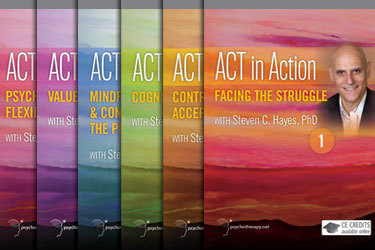Video Review — ACT in Action: 6-Video Series
 Whether a counselor is working with a mother experiencing anxiety and depression, a man presenting with severe social anxiety, a teacher with panic symptoms, an individual battling chronic pain, or a recovering alcoholic, Hayes and other contributing therapists in the ACT in Action DVD Series provide a solid foundation for practitioners to understand the main principles and processes involved in Acceptance and Commitment Therapy (ACT). Hayes effectively delivers in each of his 6 DVDs, providing extensive details and instruction. For each DVD, Hayes further created an instructor’s manual resource that includes a complete transcript, summarizes basic treatment principles and strategies, offers discussion questions, and provides information on additional websites, readings, and videos.
Whether a counselor is working with a mother experiencing anxiety and depression, a man presenting with severe social anxiety, a teacher with panic symptoms, an individual battling chronic pain, or a recovering alcoholic, Hayes and other contributing therapists in the ACT in Action DVD Series provide a solid foundation for practitioners to understand the main principles and processes involved in Acceptance and Commitment Therapy (ACT). Hayes effectively delivers in each of his 6 DVDs, providing extensive details and instruction. For each DVD, Hayes further created an instructor’s manual resource that includes a complete transcript, summarizes basic treatment principles and strategies, offers discussion questions, and provides information on additional websites, readings, and videos.
During the first video of this series, Facing the Struggle, Hayes beautifully normalizes the human condition, shows how pain represents an ally, and demonstrates the process of obtaining informed consent using an ACT approach. In his second video, Control and Acceptance, Hayes delicately illustrates techniques to help clients accept what they cannot control and behave based on personal values. This video uses appropriate self-disclosure and provides the audience with warning signs and strategies to overcome what Hayes labels “pseudoacceptance.” Similarly, in video three, Cognitive Defusion, clinicians implement a variety of thought-diffusion techniques, such as deliteralization, and physicalizing, which can be easily integrated into therapists’ toolboxes and used to reduce anxiety and depression. Appropriate metaphors allow Hayes to connect with material presented in earlier DVDs.
During the fourth DVD, Mindfulness, Self, and Contact with the Present Moment, Hayes provides the audience with a fruitful dialogue on mindfulness practices. Specifically, he demonstrates using an eyes-closed exercise with a recovering addict to promote self-mind-body connection and deeper engagement in therapy. In this DVD, ACT co-founder Kelly Wilson further demonstrates the utility of ACT in clinical supervision with another therapist working with a resistant client. In this segment, viewers observe powerful role-plays and other empowering techniques for ACT therapists.
Values and Action and Psychological Flexibility, the fifth and sixth DVD in the series, demonstrate how each prior process, component, and ACT technique build upon and work together. Values and Action highlights the significance of values in psychotherapy and the importance of identifying, incorporating, and creating meaningful goals based on personal values. In the example of working with a client diagnosed with Obsessive-Compulsive Disorder (OCD), exposure exercises are implemented and viewers observe what it means for clients to remain in the present moment without engaging in defense mechanisms, while concurrently remaining grounded and practicing psychological flexibility. These final two DVDs are highly active and show the ways that ACT can be applied across gender, age, race, socioeconomic status, disability status and cultural background.
In this DVD series, the authors do a sufficient job of demonstrating how clinicians with a variety of therapeutic styles can adopt components of ACT in their own practices, while also noting that this approach is no better than others. For example, Hayes demonstrates how ACT serves as a brief but integrative approach, combining elements from mindfulness, cognitive-behavioral therapy and interpersonal therapy. Throughout the series, Hayes provides summaries and explanations for what he is doing and why to enhance the understanding of his audience.
While this series includes numerous strengths, several caveats and limitations should be noted. At times, the terminology is complex and vague (e.g., cognitive entanglement; creative hopelessness) and it would be helpful to give visual and written definitions, or at least link audience members not as familiar with ACT to specific handouts to obtain such definitions. Another area for improvement relates to the video recording procedures; at times, the camera zooms in on Hayes and the audience may benefit from seeing the client’s non-verbal behaviors or reactions to Hayes. Third, a gun analogy is used during Control and Acceptance and the current reviewer found this technique somewhat violent and inappropriate to use with clients. Finally, the DVD series would be more complete if it included Hayes using ACT to work with a resistant client.
Watching these DVDs is probably more helpful than reading books and articles, as audience members visually observe key processes involved in ACT. Additionally, clinicians and other professionals in the field who are interested in honing his/her ACT skills can learn practical tools to use in psychotherapy with over twelve hours of instruction, live sessions and diverse therapeutic case examples. The author skillfully enlists several ACT therapists from across the United States to participate in this DVD series, including Ann Bailey-Ciarrochi, JoAnne Dahl, Rainer Sonntag, Kirk Strosahl, Robyn Walser, Rikard Wicksell, and Kelly Wilson. In summary, viewers will develop significant insight into applying ACT with a variety of clients and in numerous therapeutic settings after watching this entire series.
Visit http://www.psychotherapy.net/ to read more about the series.
Hayes, S.C. (Ed.). (2007). ACT in Action DVD Series. Oakland, CA: New Harbinger.
Reviewed by: Mary-Catherine McClain, Johns Hopkins University Counseling Center, Baltimore, MD.
The Professional Counselor
